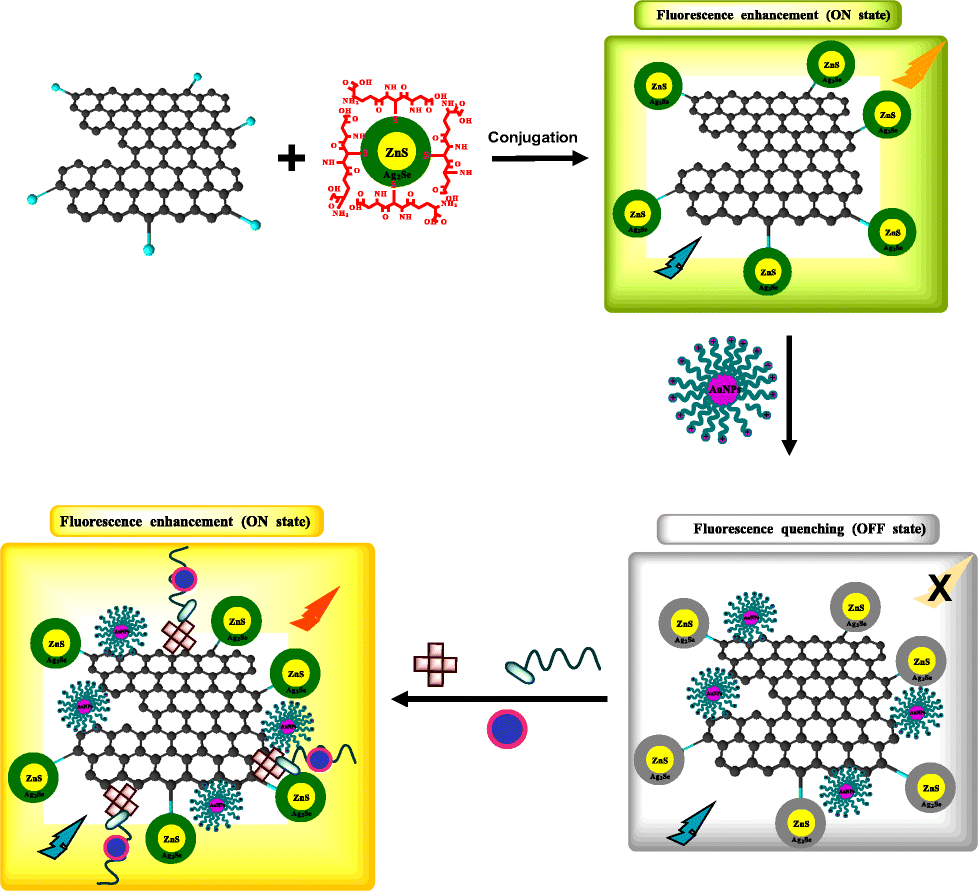当前位置:
X-MOL 学术
›
Microchim. Acta
›
论文详情
Our official English website, www.x-mol.net, welcomes your
feedback! (Note: you will need to create a separate account there.)
Aptamer-based cocaine assay using a nanohybrid composed of ZnS/Ag2Se quantum dots, graphene oxide and gold nanoparticles as a fluorescent probe
Microchimica Acta ( IF 5.3 ) Pub Date : 2020-01-08 , DOI: 10.1007/s00604-019-4101-6 Oluwasesan Adegoke 1 , Magda A Pereira-Barros 1 , Svetlana Zolotovskaya 2 , Amin Abdolvand 2 , Niamh Nic Daeid 1
Microchimica Acta ( IF 5.3 ) Pub Date : 2020-01-08 , DOI: 10.1007/s00604-019-4101-6 Oluwasesan Adegoke 1 , Magda A Pereira-Barros 1 , Svetlana Zolotovskaya 2 , Amin Abdolvand 2 , Niamh Nic Daeid 1
Affiliation

|
Authors report on a new fluoro-graphene-plasmonic nanohybrid aptamer-based fluorescent nanoprobe for cocaine. To construct the nanoprobe, newly synthesized glutathione-capped ZnS/Ag2Se quantum dots (QDs) were first conjugated to graphene oxide (GO) to form a QD-GO nanocomposite. The binding interaction resulted in a fluorescence turn-ON. Thereafter, cetyltrimethylammonium bromide (CTAB)-gold nanoparticles (AuNPs) were directly adsorbed on the QD-GO nanocomposite to form a novel QD-GO-CTAB-AuNP nanohybrid assembly that resulted in a fluorescence turn-OFF. Streptavidin (strep) was then adsorbed on the QDs-GO-CTAB-AuNP nanohybrid assembly which allowed binding to a biotinylated MNS 4.1 anticocaine DNA aptamer (B) receptor. The addition of cocaine into the strep-B-QDs-GO-CTAB-AuNP aptamer nanoprobe system aided affinity to the aptamer receptor and in turn turned on the fluorescence of the nanoprobe in a concentration-dependent manner. Under optimum experimental conditions, we found the strep-B-QD-GO-CTAB-AuNP to be far superior in its sensitivity to cocaine than the tested strep-B-QDs (no GO and CTAB-AuNPs), strep-B-QD-CTAB-AuNP (no GO) and strep-B-QD-GO (no CTAB-AuNP). In addition, the investigation of localized surface plasmon resonance (LSPR) amplified signal from tested plasmonic NPs shows that CTAB-AuNPs was far superior in amplifying the fluorescence signal of the nanoprobe. A detection limit of 4.6 nM (1.56 ng.mL−1), rapid response time (~2 min) and excellent selectivity against other drugs, substances and cocaine metabolites was achieved. The strep-B-QD-GO-CTAB-AuNP aptamer-based fluorescent nanoprobe was successfully applied for the determination of cocaine in seized adulterated cocaine samples. Graphical abstract Schematic representation of the streptavidin-biotin-quantum dot-graphene oxide-cetyltrimethylammonium bromide-gold nanoparticle aptamer-based fluorescent nanoprobe for cocaine. Schematic representation of the streptavidin-biotin-quantum dot-graphene oxide-cetyltrimethylammonium bromide-gold nanoparticle aptamer-based fluorescent nanoprobe for cocaine.
中文翻译:

使用由 ZnS/Ag2Se 量子点、氧化石墨烯和金纳米颗粒组成的纳米混合物作为荧光探针的基于适体的可卡因测定
作者报告了一种新的基于氟-石墨烯-等离子体纳米杂化适体的可卡因荧光纳米探针。为了构建纳米探针,首先将新合成的谷胱甘肽封端的 ZnS/Ag2Se 量子点 (QD) 与氧化石墨烯 (GO) 共轭以形成 QD-GO 纳米复合材料。结合相互作用导致荧光开启。此后,十六烷基三甲基溴化铵 (CTAB)-金纳米粒子 (AuNPs) 直接吸附在 QD-GO 纳米复合材料上,形成新型 QD-GO-CTAB-AuNP 纳米复合组件,导致荧光关闭。然后将链霉亲和素 (strep) 吸附在 QDs-GO-CTAB-AuNP 纳米杂交组件上,这允许与生物素化的 MNS 4.1 抗卡因 DNA 适体 (B) 受体结合。将可卡因添加到链球菌-B-QDs-GO-CTAB-AuNP 适配体纳米探针系统中有助于与适配体受体的亲和力,进而以浓度依赖性方式开启纳米探针的荧光。在最佳实验条件下,我们发现 strep-B-QD-GO-CTAB-AuNP 对可卡因的敏感性远优于测试的 strep-B-QD(无 GO 和 CTAB-AuNP)、strep-B-QD -CTAB-AuNP(无 GO)和 strep-B-QD-GO(无 CTAB-AuNP)。此外,对来自测试等离子体 NP 的局部表面等离子体共振 (LSPR) 放大信号的研究表明,CTAB-AuNP 在放大纳米探针的荧光信号方面要优越得多。实现了 4.6 nM (1.56 ng.mL-1) 的检测限、快速响应时间(~2 分钟)以及对其他药物、物质和可卡因代谢物的出色选择性。基于链球菌-B-QD-GO-CTAB-AuNP 适配体的荧光纳米探针成功应用于检获的掺假可卡因样品中可卡因的测定。用于可卡因的链霉亲和素-生物素-量子点-氧化石墨烯-十六烷基三甲基溴化铵-金纳米颗粒适体荧光纳米探针的示意图。用于可卡因的链霉亲和素-生物素-量子点-氧化石墨烯-十六烷基三甲基溴化铵-金纳米颗粒适体荧光纳米探针的示意图。用于可卡因的链霉亲和素-生物素-量子点-氧化石墨烯-十六烷基三甲基溴化铵-金纳米颗粒适体荧光纳米探针的示意图。用于可卡因的链霉亲和素-生物素-量子点-氧化石墨烯-十六烷基三甲基溴化铵-金纳米颗粒适体荧光纳米探针的示意图。用于可卡因的链霉亲和素-生物素-量子点-氧化石墨烯-十六烷基三甲基溴化铵-金纳米颗粒适体荧光纳米探针的示意图。用于可卡因的链霉亲和素-生物素-量子点-氧化石墨烯-十六烷基三甲基溴化铵-金纳米颗粒适体荧光纳米探针的示意图。
更新日期:2020-01-08
中文翻译:

使用由 ZnS/Ag2Se 量子点、氧化石墨烯和金纳米颗粒组成的纳米混合物作为荧光探针的基于适体的可卡因测定
作者报告了一种新的基于氟-石墨烯-等离子体纳米杂化适体的可卡因荧光纳米探针。为了构建纳米探针,首先将新合成的谷胱甘肽封端的 ZnS/Ag2Se 量子点 (QD) 与氧化石墨烯 (GO) 共轭以形成 QD-GO 纳米复合材料。结合相互作用导致荧光开启。此后,十六烷基三甲基溴化铵 (CTAB)-金纳米粒子 (AuNPs) 直接吸附在 QD-GO 纳米复合材料上,形成新型 QD-GO-CTAB-AuNP 纳米复合组件,导致荧光关闭。然后将链霉亲和素 (strep) 吸附在 QDs-GO-CTAB-AuNP 纳米杂交组件上,这允许与生物素化的 MNS 4.1 抗卡因 DNA 适体 (B) 受体结合。将可卡因添加到链球菌-B-QDs-GO-CTAB-AuNP 适配体纳米探针系统中有助于与适配体受体的亲和力,进而以浓度依赖性方式开启纳米探针的荧光。在最佳实验条件下,我们发现 strep-B-QD-GO-CTAB-AuNP 对可卡因的敏感性远优于测试的 strep-B-QD(无 GO 和 CTAB-AuNP)、strep-B-QD -CTAB-AuNP(无 GO)和 strep-B-QD-GO(无 CTAB-AuNP)。此外,对来自测试等离子体 NP 的局部表面等离子体共振 (LSPR) 放大信号的研究表明,CTAB-AuNP 在放大纳米探针的荧光信号方面要优越得多。实现了 4.6 nM (1.56 ng.mL-1) 的检测限、快速响应时间(~2 分钟)以及对其他药物、物质和可卡因代谢物的出色选择性。基于链球菌-B-QD-GO-CTAB-AuNP 适配体的荧光纳米探针成功应用于检获的掺假可卡因样品中可卡因的测定。用于可卡因的链霉亲和素-生物素-量子点-氧化石墨烯-十六烷基三甲基溴化铵-金纳米颗粒适体荧光纳米探针的示意图。用于可卡因的链霉亲和素-生物素-量子点-氧化石墨烯-十六烷基三甲基溴化铵-金纳米颗粒适体荧光纳米探针的示意图。用于可卡因的链霉亲和素-生物素-量子点-氧化石墨烯-十六烷基三甲基溴化铵-金纳米颗粒适体荧光纳米探针的示意图。用于可卡因的链霉亲和素-生物素-量子点-氧化石墨烯-十六烷基三甲基溴化铵-金纳米颗粒适体荧光纳米探针的示意图。用于可卡因的链霉亲和素-生物素-量子点-氧化石墨烯-十六烷基三甲基溴化铵-金纳米颗粒适体荧光纳米探针的示意图。用于可卡因的链霉亲和素-生物素-量子点-氧化石墨烯-十六烷基三甲基溴化铵-金纳米颗粒适体荧光纳米探针的示意图。











































 京公网安备 11010802027423号
京公网安备 11010802027423号